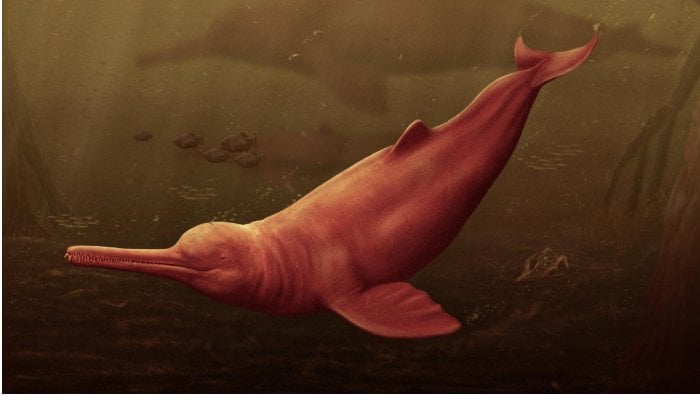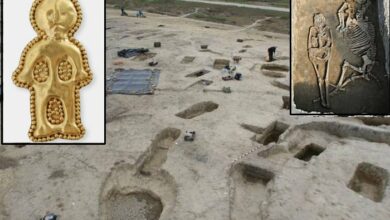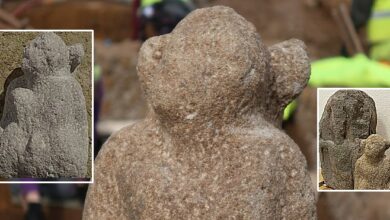A New Species Of Giant Freshwater Dolphin Discovered In The Peruvian Amazon

Eddie Gonzales Jr. – AncientPages.com – Paleontologists from the University of Zurich have made an exciting discovery in the Peruvian Amazon – a new species of freshwater dolphin that’s between 3 and 3.5 meters long and dates back a whopping 16 million years.
Pictorial reconstruction of Pebanista yacuruna in the murky waters of the Peruvian proto-Amazon. (Image: Jaime Bran)
Interestingly, this ancient creature’s closest living kin is not found nearby, but rather they’re the river dolphins residing in Southeast Asia.
The discovery of this new species dubbed Pebanista yacuruna (a name inspired by the legendary water-dwelling tribes of the Amazon basin), is quite fascinating. This ancient creature, unearthed in the depths of the Peruvian Amazon, is believed to have roamed our planet about 16 million years ago.
Landscape changed causing giant dolphins to become extinct
The newly discovered dolphin species is a member of the Platanistoidea family, a group of dolphins that were prevalent in global oceans from 24 to 16 million years ago.
The researchers theorize that these sea-dwelling ancestors ventured into the nutrient-rich freshwater ecosystems of early Amazonia, adjusting and evolving to thrive in this different environment.
“16 million years ago, the Peruvian Amazon looked completely different than it does today,” says lead author Aldo Benites-Palomino from the UZH Institute of Paleontology in a press release.
“A large part of the Amazon lowland was covered by an extensive system of lakes and swamps, the Pebas.” This landscape included aquatic, semiaquatic, and terrestrial ecosystems (swamps, floodplains, etc.) and spanned what is now Colombia, Ecuador, Bolivia, Peru, and Brazil.
Around 10 million years ago, the Pebas system started transforming into what we now know as the Amazon region. This change caused the extinction of certain species, including the giant dolphin’s prey, which eventually led to its own extinction. However, this opened up a new ecological niche that was filled by the ancestors of today’s Amazon river dolphins (Inia).
These creatures were pushed out of their ocean habitats by newly evolved whales and dolphins like modern ocean dolphins.
Insights into the evolutionary history of freshwater dolphins
“We discovered that it wasn’t just the size of the dolphin we described that was remarkable,” says Aldo Benites-Palomino. “We expected this fossil found in the Amazon to be a close relative of the living Amazon dolphin – instead, the Pebanista is related to the South Asian river dolphins (genus Platanista).”
Both the Pebanista and Platanista have highly developed facial ridges, specialized bone structures associated with echolocation. This gives them the ability to “see” by emitting high-frequency sounds and hearing echoes, which they heavily depend on when hunting, according to the researchers.
“Echolocation, also known as biosonar, is even more important for river dolphins. The waters in which they live are extremely muddy, which hinders their visibility,” explains Gabriel Aguirre-Fernández, a postdoc at UZH and also involved in the study. The elongated snout with many teeth suggests that Pebanista fed on fish, as other river dolphin species do today.
“After two decades of work in South America, we have found several giant forms from the region, but this is the first dolphin of its kind,” adds Marcelo R. Sánchez-Villagra, director of the UZH Paleontological Institute. “We were particularly fascinated by its special biogeographical history.”
Searching for fossils in the Amazon area
The Amazon rainforest poses significant challenges for paleontological fieldwork. Fossils are only available during the dry season, when receding river levels reveal the ancient fossil-laden rocks. If these fossils aren’t promptly collected, they risk being swept away by floods in the rainy season, resulting in permanent loss.
The holotype of Pebanista – a unique specimen that forms the basis for describing and naming a new species – was discovered in 2018. Interestingly, at that time, the lead author of this study was still an undergraduate student.
The expedition was spearheaded by Rodolfo Salas-Gismondi, a Peruvian paleontologist and former postdoc at UZH Institute of Paleontology. This team journeyed over 300 kilometers along Rio Napo to make this significant find.
Written by Eddie Gonzales Jr. – AncientPages.com – MessageToEagle.com Staff Writer





